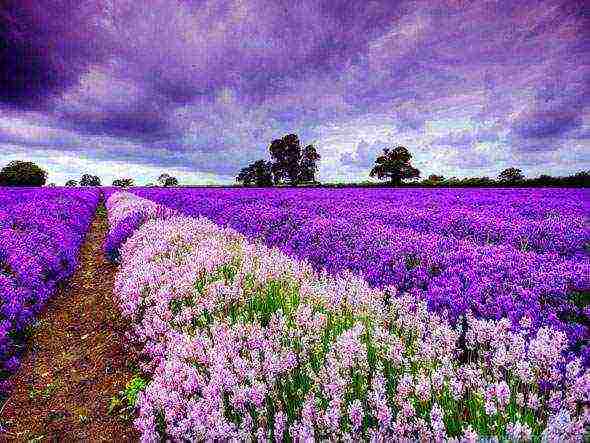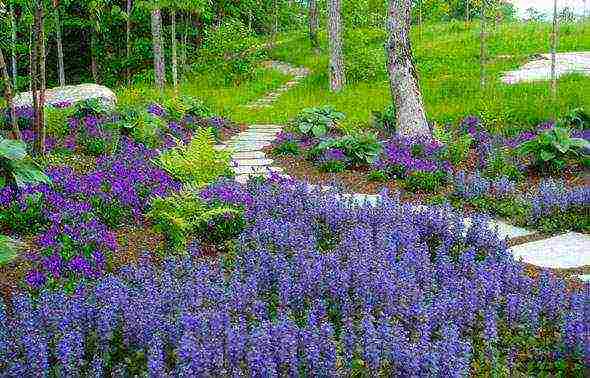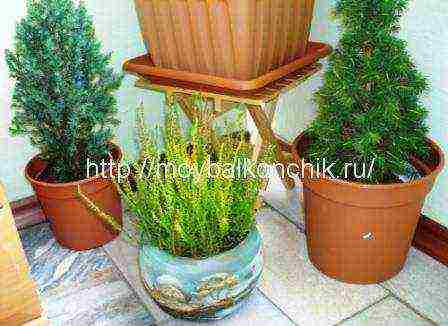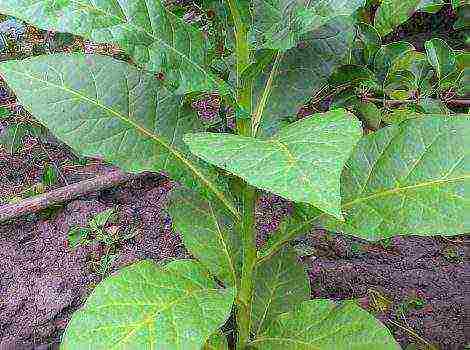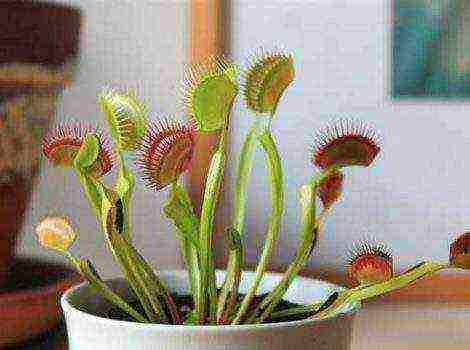Content
- 1 Landing place
- 2 Features of planting lavender
- 3 Sowing lavender seeds
- 4 Soil processing near bushes
- 5 Pruning lavender bushes
- 6 Fertilization
- 7 Preparing for winter
- 8 Types of lavender
- 9 Landing place
- 10 Features of planting lavender
- 11 Sowing lavender seeds
- 12 Soil processing near bushes
- 13 Pruning lavender bushes
- 14 Fertilization
- 15 Preparing for winter
- 16 Types of lavender
- 17 How to choose the right seat for landing
- 18 Planting lavender outdoors
- 19 Breeding lavender
- 20 Breeding by layering
- 21 Proper soil care
- 22 Formation of bushes
- 23 Fertilizing the soil
- 24 How to prepare lavender for winter
- 25 Popular types and varieties of lavender
 In general, lavender is quite a convenient plant to grow in the country or in your own garden.
In general, lavender is quite a convenient plant to grow in the country or in your own garden.
You just need to know some of the features and be able to competently dispose of this plant.
For example, if your weather is mostly cold, you can use portable pots and flowerpots..
There, lavender will feel great, and you can move the plant to more comfortable conditions when it gets colder.
Of course, in addition to this, you will need and regularly take care of lavender, but, we repeat, if you know exactly what to do and the features of the plant, lavender will be able to delight you with its magnificent appearance.
Landing place
Perhaps it is one of the most important parameters. After all, if you choose a shady space, then there will be few flowers, and the flowering period is minimal. Under the rays of light, lavender opens up and blooms for a long time, gives many flowers.
It is best to choose fairly free open spaces, but you need to look not only at the situation above the ground, but also underground. If you are the proud owner of high groundwater resources, you should consider an artificial lavender hill or drainage layer.
This plant does not tolerate waterlogged and waterlogged soil, by the way, flowerpots here can also be the best option.
When making a lavender bed, use compost, which will increase the nutrient content of the soil and loosen the soil. If acidity prevails in the soil, you will need to add a little alkali, for example, wood ash, or lime.
Features of planting lavender
 In general, you have three options for getting new lavender bushes:
In general, you have three options for getting new lavender bushes:
- seeds - just buy seeds and grow according to the instructions;
- stalk - you cut a twig and put it in the soil mixture, moisten the soil (you can cover it with a film or make a "greenhouse" effect in another way) and after the stalk has taken root, transplant it to the desired location;
- layering - in the spring, take the lower branch and tilt it to the ground, sprinkle the part closest to the ground with earth, you can additionally fix the branch, as a result, a lump of roots will appear in contact with the ground, then cut off the branch from the main bush, sprinkle the cut with crushed coal and plant the layering.
If we talk about adult bushes, then they are not particularly transplanted.... This is possible, but you need to act very carefully and take a large amount of soil with roots.
Regarding the distance between bushes, there is a universal parameter - the maximum length of a bush. Take this length as the distance between adjacent bushes if you want the lavender to grow luxuriantly.
If you want a hedge, then take the distance between the bushes at half the maximum length.
Sowing lavender seeds
Here you need the so-called stratification, that is, artificial cooling.Most often, where winters are harsh, aging in the refrigerator or on the balcony is used for stratification.
To do this, they take seeds, mix them with sand, put them in a container, wrap them in plastic and leave them in the cold for at least six weeks, up to -8 - 12 degrees.
It is necessary not to freeze the seeds. After that, you can plant lavender in boxes at the end of winter, or in greenhouses and open ground in the spring. It is quite important to wait for spring, since the longer the stratification, the better.
If you live where winters are not so harsh, you may well plant seeds right away in early autumn. Some will overwinter and begin to grow, but this option is relevant only if you live in a warm climatic zone.
Soil processing near bushes
Watering is a very significant factor. Watering is optimal depending on the drying out of the soil. When the soil is dry, you can water it again, but you should not overmoisten it.
In addition, loosening and weeding will be required, and regular... If you want to make things a little easier for yourself, use foliage mulch, which will soften and loosen the soil, but it still takes a little work. Near the bush, the soil should not be covered with mulch so that the roots do not rot, there will need to be weeded a little.
Pruning lavender bushes
When the first spikelets have wilted, you need to do the first pruning of the branches. Cut off literally a couple of centimeters. Before the cold season, cut a little more, but still not much.
In general, lavender should never be trimmed to the ligneous part. This process as a whole has only decorative purposes, you form a beautiful bush shape. Therefore, in general, this activity is optional, but if you want to have a beautiful plant, it is sometimes helpful to trim the lavender.
Fertilization
 Miracle mulch will help you here too.
Miracle mulch will help you here too.
If you don't particularly want to spend time fertilizing the bushes and have some foliage and compost at your disposal, you can put a thick layer near the plants and the mulch will do the job for you.
When decomposing, this layer will be able to provide all the necessary elements for plants.
In addition, you can take:
- mineral (complexes) fertilizers - the simplest from a flower shop, two tablespoons per bucket and water around the perimeter before flowering;
- nitrogen fertilizers - identical proportions, used only at the beginning of summer.
They will give the plant the support it needs, but when thick mulch is available, it really isn't as relevant.
Preparing for winter
While lavender loves warmth, experts say, the plant can tolerate periods as low as -25 degrees. The most significant negative factor here can only be winter with a minimum amount of snow, when soils freeze and frosts are more noticeable for plants.
One way or another, it is useful for lavender to create additional insulation if you intend to winter outdoors.
In order to neutralize the possible lack of snow, use branches of coniferous trees. Before this, deciduous mulch must be completely removed and a couple of floors of coniferous insulation are laid on the beds. In addition, before winter, you should trim the branches a little.
If your lavender lives in warm climatic zones, then you may not need to insulate the beds. Often, the plant tolerates wintering quite well.
Types of lavender
 In reality, lavender flowers can vary in color.
In reality, lavender flowers can vary in color.
Much depends on the variety, although the most common is still the option with purple flowers.
There are two main groups of lavender:
- English.
- French.
The first option is the most unpretentious and is used for growing in open fields. Here the inflorescences are longer and the leaves are narrower.
The second option is mostly grown in pots, since French lavender freezes from cold weather, the plant has shorter inflorescences and larger leaves, although in general it looks like English lavender.
Lavender
- a beautiful plant that conquers with its graceful, delicate aroma. She has gained wide popularity among gardeners for a very long time. Fluffy bushes of lavender, dazzling with bright inflorescences-spikelets - a great plant for borders,
alpine slides
and
rockeries
.
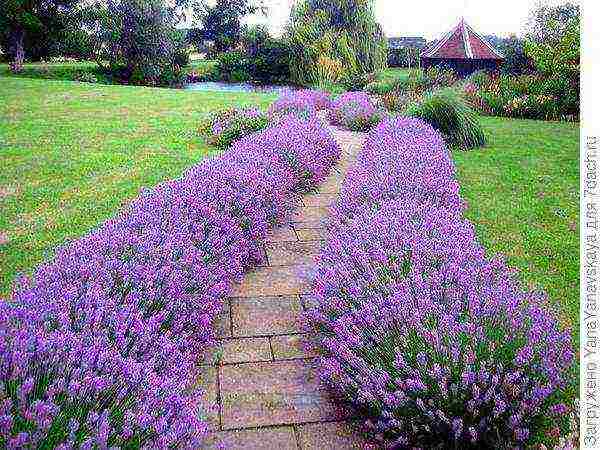
And you can learn about the beneficial properties of lavender from the article.
"Lavender: beauty and benefit!"
.
Of course, to get a luxurious flower bed, you have to try. Lavender care is required on a regular basis. The complex of measures must include:
- loosening the soil;
- elimination of weeds;
- watering;
- pruning;
- fertilization;
- preparation for winter.
Lavender is a thermophilic plant. Therefore, to grow this
perennial
in the open field it is not possible in any climatic zone. In cold climates, the bushes should be planted in
flowerpots
and at the first hint of a cold snap, quickly transfer them to a warm place. Any variety of lavender can be grown as a pot plant.
Landing place
The key to successful
growing lavender - the right choice of landing site. Most of all, the plant will like open areas, well-lit by the sun's rays. The bushes will take root in the shade, but it will not be possible to achieve abundant and long flowering.
Plant roots are sensitive to high soil moisture levels. Therefore, you should refrain from planting lavender in wetlands and areas where they lie too high
groundwater
... If there is no other option, you can try to build a hill and plant bushes on it. Excess moisture near the roots can be easily removed with a drainage layer.

Any variety of lavender can be grown as a pot plant.
Lavender is also demanding about the level of acidity and soil structure. Therefore, if in doubt, it is better to play it safe - before boarding, deposit in
soil
a little woody
ash
or lime. These are effective soil deoxidizers. And to ensure the porous structure of the soil, it is enough to regularly apply to the garden
compost
... It will not only loosen the soil, but also supplement it with nutrients.
Features of planting lavender
Planting lavender - a responsible process. Adult bushes do not tolerate transplanting well, if you have to do it, then carefully and only with a voluminous lump of earth. It is better to immediately determine where the bushes grown from seeds, cuttings or cuttings will be located.
The distance between adjacent specimens should be approximately equal to their maximum height. Then the bushes will be lush. And to get slender green
hedges
we reduce this parameter by half. This way you can achieve the maximum solidity of the plantation block.
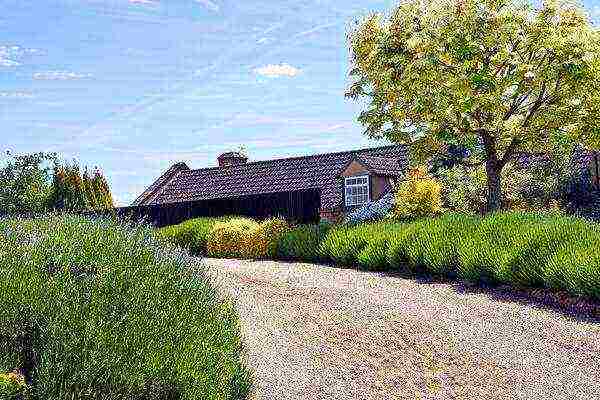
Lavender curbs are great Lavender cuttings take root quite quickly. The planting algorithm is simple: deepen a couple of centimeters into a loose soil mixture, cover with a film and regularly moisten the soil. Gently dig out the rooted cuttings and transplant to the chosen place.
Layers are rooted branches of a plant. To obtain planting material, bend one of the lower shoots to the side in the spring. Fix the place of contact with the ground level and cover with soil. When a lump of roots forms, carefully cut off the cut with a sharp knife. Sprinkle the place of the cut with crushed coal to protect it from decay processes. That's it - the layering is ready for planting.
You can choose lavender seedlings of various varieties in our catalog, where various online stores present their products. Choose lavender seedlings
Sowing lavender seeds
Lavender is difficult to propagate by seed.But if it is not possible to purchase an adult plant or twigs, you can also try sowing seeds.
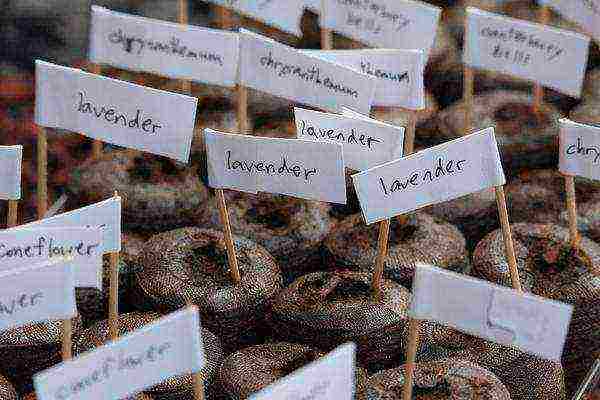
Lavender can be propagated by seed. A very important step is stratification. Lavender seeds need to be kept at low temperatures for some time. Here you can go in two ways: plant them at the end of autumn immediately in the ground or carry out artificial stratification. The first method is only suitable for warm climates. With significant frosts, seeds may die. Therefore, it is better to opt for the second option.
For artificial stratification, the seeds must be mixed with a small amount of sand, poured into a container, wrapped in polyethylene and refrigerated. Keep them there for at least a month and a half. Better - longer. In this case, seedlings will appear faster. Then you can sow seeds in boxes (at the end of winter) or in
greenhouses
outside (late spring).
When sowing with seeds, it will take a whole year to expect flowering. In the first seasons, seedlings will only develop, increasing the root system. And only after a year, and maybe even after two, they will delight the gardener with cute spikelets-inflorescences.
You can choose lavender seeds in our catalog, where products from various online stores are presented. Select lavender seeds
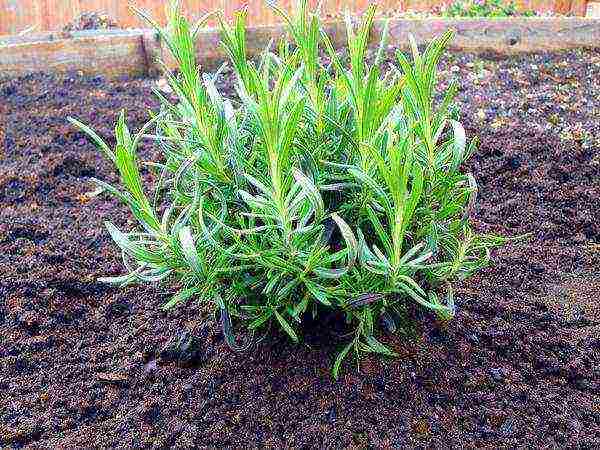
Lavender grown from seed will only flower for 2-3 years.
Soil processing near bushes
Lavender does not like dense soils. Its roots really need good air circulation. In addition, of course, you need to get rid of pest weeds next to lavender. Therefore, loosening and weeding should become a regular procedure.
You can do it easier - organize a good mulching layer on the lavender garden. As
mulch
you can use the decayed
foliage
or decorative multi-colored substrates. But in any case, near the base of the trunk, the soil should remain uncovered. This will keep the plant from rotting.
Water the lavender very carefully. Excessive irrigation can lead to root rot and yellowing of the aerial part of the plant. Drought is also bad for the plant - the lavender will not die, but the flowering will not be as luxurious as we would like. The ideal watering regime is as the soil dries up.
Pruning lavender bushes
This stage of lavender care cannot be called mandatory. But only by pruning can you achieve the formation of beautiful lush bushes. Therefore, you should not give up a useful procedure.

Pruning lavender The first pruning should be done immediately after the inflorescence spikelets wilt. You need to shorten the shoots literally by a couple of centimeters. At the end of the warm season, more drastic pruning is carried out. But here, too, you should not show excessive enthusiasm. If you shorten all the branches to the level of the lignified part, the bush may die.
Fertilization
Great as a fertilizer for lavender
mineral
complexes that are sold in all garden and flower shops. They should be applied during the beginning of flowering. Concentration - 2 tbsp. spoons in a bucket of water. With the resulting solution, you need to shed soil around the perimeter of the bushes.
Responsible for the development of green mass
nitrogen fertilizers
(2 tablespoons per bucket). Therefore, they are indispensable at the beginning of the growing season (growth). But in the second half of the summer, it is forbidden to use them. Under the influence of nitrogen, the growing season is significantly extended. As a result, the plant does not have time to prepare for wintering.
The use of fertilizers can be completely abandoned if there is a thick layer of compost mulch under the bushes. Decomposing under the influence of external factors, it will supply the plant with nutrients throughout the season.
Preparing for winter
For lavender bushes that have to spend the winter outdoors, you can organize a reliable
shelter
... True, in warm climatic zones, you can do without this - according to experts, lavender will survive the winter well, even if the temperature drops to -25 ° C. If frosts are expected stronger than this mark, insulation is necessary. In addition, it will not be superfluous to play it safe in cases where the winter may turn out to be little snow.
At the end of the season, lavender bushes are pruned. Branches are laid on top of the garden bed (best of all from conifers). But the usual insulation in the form of a layer of foliage is not suitable. Lavender can rot under it.

In general, caring for lavender is not as difficult as it might seem at first glance. Using compost mulch will eliminate weeding, loosening and top dressing. Therefore, the gardener will only have to cut the bushes in a timely manner so that they grow strong and bloom profusely.
The topical question "How to preserve lavender in winter" was asked by a reader of our site. You can read the tips and take part in the discussion.
Types of lavender
Many people associate lavender bushes with a constant purple color. In fact, shades of different varieties conquer with variety. There are specimens with blue, white, pink and even greenish colors. And this is just the basic palette. And the shades of inflorescences-spikelets are even more. But color is not the only difference between different lavender varieties.
According to the generally accepted classification, there are two broad groups:
english and
french .
English lavender - the owner of narrow leaves and elongated spikelets-inflorescences. It is worth noting that it is this type that has received the most widespread use. Such varieties winter quietly in the middle lane, without needing to be dug up in late autumn.
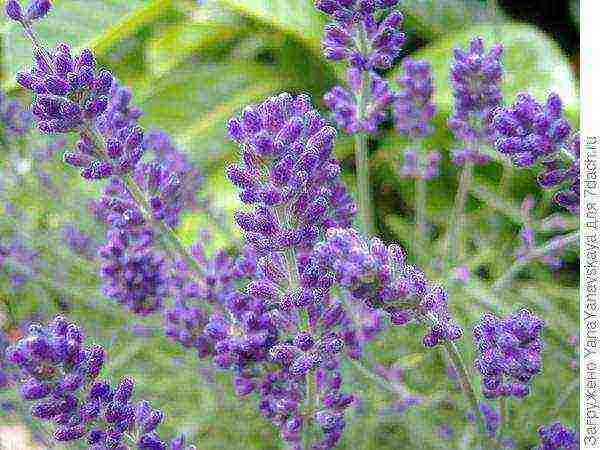
French lavender - a more capricious plant. Outwardly, it is similar to the previous species, but its leaves are wider, and the inflorescences are shorter. Traditionally used as a pot culture. After all, even minor frosts down to -15 ° C can instantly destroy the plant.
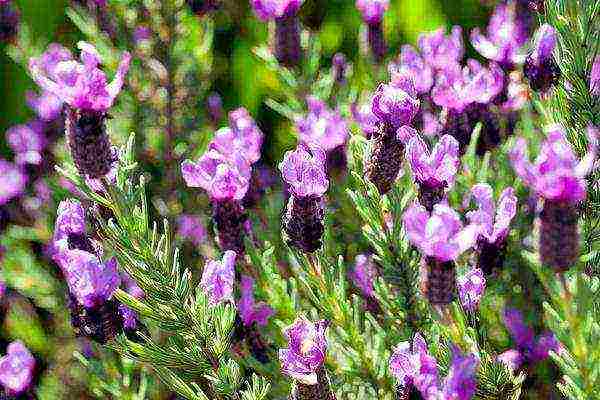
French lavenderAll articles about lavender on our website
Lavender is a perennial shrub evergreen with vibrant flowers and a wonderful scent. Silvery-green leaves grow along the stems, the flowers are blue or purple, depending on the species, and are collected in inflorescences of spikelets. Lavender has long gained popularity among gardeners. These flowers are often used to decorate alpine slides, borders.
Loading …
Naturally, in order to get a beautiful flower garden, it is necessary to provide comprehensive regular plant care, which will include:
- loosening the soil;
- watering;
- removal of weeds;
- undercutting;
- top dressing of the soil;
- preparation for wintering.
Given that lavender loves warmth, it will not work to grow it in any climate. In northern latitudes, this plant is optimally grown in flowerpots, which can be easily removed from the street to a warm room when cold weather sets in.
How to choose the right seat for landing
It is important to choose the optimal place for planting this plant, only then it is possible to ensure that the flowering is long. Better to give preference to open, unshaded areas.
The root system of lavender reacts negatively to increased soil moisture. This means that you need to abandon planting a plant in an area that has groundwater or is swampy. But if you still decide to plant a plant in such a place, you should create an elevation or lay a drainage layer at the bottom of the planting site.
Lavender is also very sensitive to soil acidity levels. Based on this, in order to be on the safe side, you need to flavor the soil before planting with lime or wood ash - they neutralize acidity. To ensure the soil is loosened, it is necessary to periodically sprinkle the soil with compost, which will allow, in addition, to saturate the soil with useful elements.
Any variety of lavender can be grown as a pot plant.
Planting lavender outdoors
Planting plants is always a very crucial moment. Adult plants tolerate transplanting worse, so it is better to plant them from the soil in which they grew, without shaking it off the root system. And you should decide in advance where the seeds will be sown, where are the plants grown from cuttings, and where are the shrubs.
If you want to get lush bushes, then you should make the distance between the plants equal to their height, as advised by experienced gardeners. If you need dense growth, like a hedge, then you need to cut the distance in half.
To speed up the rooting process, you need to place the roots in water for 60-90 minutes before planting. The beds should be made high, about 20 cm. Remove all lower branches and leaves from the bush and cut off the top, which will give an impetus for the speedy growth of new shoots. The depth of the hole for planting must be made about 30 cm.
Breeding lavender
There are several ways to grow flowers: seeds, cuttings and layering.
Sowing lavender seeds
Growing lavender from seeds is a very difficult and painstaking process, you can use it if you cannot buy a young bush.
The very first stage is stratification - exposure of seeds to low temperatures. This allows the plant to grow strong and overwinter easily.
There are two types of stratification:
- Natural. Seeds are planted on the site in the fall. Having survived the winter, the plant gains good immunity. But this method is only suitable for warm climates, otherwise the frost will kill the seeds.
- Artificial. The seeds are mixed with sand in small containers, wrapped in polyethylene and put into the refrigerator for 1.5 months. In winter, the prepared seeds are planted in pots. Or in the spring on a plot in a greenhouse. This method is suitable for colder climates.
When breeding these plants with seeds, you should expect flowering only next year.
Growing from a cutting
This is the easiest way to grow lavender. The grafting procedure is the same as for any other plant:
- cut off the stiff shoot of an annual bush;
- divide the shoot into cuttings;
- plant the cuttings in pre-prepared soil to a depth of 2-3 cm;
- make a greenhouse over the seedlings;
- watering.
Loading …
Breeding by layering
Even a novice gardener can handle this breeding technique. At the beginning of the season, the shoot of the bush must be pressed to the ground and buried in a hole, leaving only the top outside. To keep the gadfly in the ground, you can secure it with a metal bracket, but not too tightly.
With regular watering, the cuttings will give roots in a few months. Now it can be detached and put into place.
Proper soil care
For good growth, lavender needs well-loosened soil for air circulation. You also need to regularly remove weeds. Therefore, weeding and loosening must be carried out carefully and regularly.
There is another way - mulch. Mulching in spring and autumn will perfectly loosen the soil and distribute the evaporation of moisture from the ground. In this capacity, you can use humus and various substrates that can be found in any horticultural department of stores. The main thing to remember is that the lower part of the trunk of the bush remains open, in order to avoid rotting.
Watering must be done carefully, as the earth dries up, do not overdo it, since lavender does not like a lot of moisture.
Formation of bushes
Cutting the stems of the bush is not necessary, but with this action you can give the bush a beautiful shape and splendor. This process should not be neglected.
Cutting should be done at the beginning of the summer period, as soon as the inflorescences wither by 2-3 cm.At the end of the season, in the fall, another cut, more serious, is carried out. The cut is made 2-3 cm above the stiff part of the stem.
Fertilizing the soil
You can feed the plants at the beginning of the warm period with complex fertilizers, which are also readily available in stores. In a bucket of water, add 2 tablespoons of the concentrate and pour the resulting solution over the ground between the plants.
Nitrogen fertilizer is also very suitable for the growth of greenery, which is very important at the beginning of the warm period before flowering. The solution is prepared in the same way: 2 tablespoons in a bucket of water. But later it is better not to use it, since the plant during the active growing season will not have time to prepare for wintering.
But if a layer of compost mulch was introduced before the season, then fertilizers can be abandoned for the entire flowering season, since the elements necessary for life and growth are gradually decomposing and feed the plant throughout the summer.
How to prepare lavender for winter
To create the most optimal conditions for wintering a plant in the open field, it is necessary to prune the bushes in the fall so that the plant is abundant and lush next season. You should also cover them with branches of coniferous trees. This is necessary to protect them from severe frosts from -25ºC and below. It is necessary to insure yourself in case the winter is not very snowy. It is impossible to insulate lavender with leaves, as the flowers can rot. In general, lavender is not as whimsical as it seems at first. Timely application of mulch can save time on weeding, loosening the soil and feeding.
Popular types and varieties of lavender
Most people associate lavender with purple. But this is a misconception. After all, flowers, depending on the type and variety, can be white, pink, greenish, lilac, bright blue. But the differences are not only in this.
There are more than 25 types of lavender, which differ from each other in bush height, color saturation and flowering period and planting in different climatic zones. But the following types are most popular:
- English lavender. It has narrow leaves and long spikelets. Plant height up to 50 cm. Can withstand winter in mid-latitudes without digging up in autumn. The most popular varieties of this species are Alba, Rosea and Manstad.
- French lavender. It has wide leaves and shorter inflorescences. Most often grown in flowerpots, very thermophilic. Popular varieties of this species are Yellow Vale, Rocky Road and Helmsdale.
- Dutch lavender. Possesses oblong flowers. Large bushes can reach a height of 2 m - large plants up to 2 m in height with oblong flowers. Blooms in mid-summer. Grown for industrial production. Varieties of this species: Sawyers, Arabian Knight, Richard Gray.
- Serrated lavender. The plant has a characteristic silvery leaf relief. Blooming in July. To be grown exclusively indoors, the most thermophilic species. The most popular variety of this species is Royal Crown.
Loading …
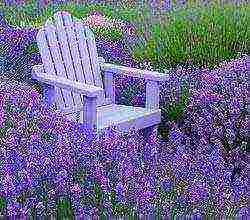 It is impossible to walk past the area where lavender grows. And the point is not even in the luxurious lilac bushes, but in the enchanting aroma that they spray around the neighborhood. And for a minute, freezing near this magic, you are already rushing home at full speed, elated. You need to find out as soon as possible: how capricious lavender plant is, are planting and care difficult, what is it sick of? After all, the fact that from now on she will be in your garden is a question that has already been resolved.
It is impossible to walk past the area where lavender grows. And the point is not even in the luxurious lilac bushes, but in the enchanting aroma that they spray around the neighborhood. And for a minute, freezing near this magic, you are already rushing home at full speed, elated. You need to find out as soon as possible: how capricious lavender plant is, are planting and care difficult, what is it sick of? After all, the fact that from now on she will be in your garden is a question that has already been resolved.
Description: varieties and varieties of lavender
Lavender is an evergreen, rather unpretentious plant widely used in cosmetology and medicine. The scent of lavender has a calming effect and helps relieve headaches. But not only medicinal properties are appreciated in lavender. It is widely used in perfumery and cosmetology. Lavender and cooking did not pass by, because this plant has a specific spicy taste. And in everyday life, dried lavender twigs are used as a reliable remedy for moths.
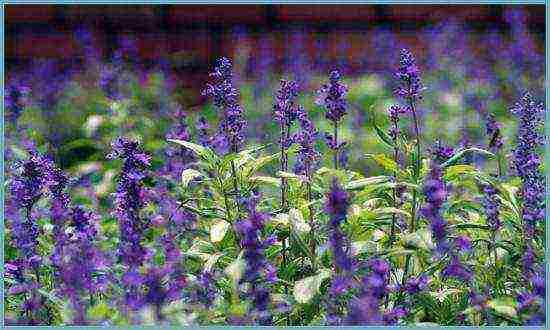
There are many varieties of lavender. Which one to plant in your garden - choose according to your taste
More than 25 types of lavender are known, but several varieties are most popular in the garden culture.
Narrow-leaved lavender (English). It is a bush no more than a meter in diameter. The leaves of this variety are medium-sized, narrow, gray-green. Blooms in June and July. The variety is unpretentious and tolerates low temperatures well.
Lavender broadleaf (French). This lavender variety is considered the ancestor of the decorative varieties. It differs from other varieties in a wide color range of inflorescences, as well as a very strong and not always pleasant aroma.
Hybrid lavender (Dutch). This variety is considered the largest. Its bushes can grow up to two meters. It is a natural hybrid of narrow-leaved and broad-leaved varieties. Blooms in July. Its frost resistance is lower than that of narrow-leaved. Refers to industrial grades.

Dutch lavender has the most beautiful flowers
Lavender toothed. One of the most thermophilic varieties. Prefers to grow indoors rather than outdoors. It is the owner of soft silvery leaves and inflorescences of large flowers in all shades of purple.
Planting a plant
Lavender can be propagated in different ways: cuttings, dividing the bush, layering, seeds. Lavender seeds can survive for many years if you follow the rule: store them in sealed containers.
Attention! Lavender seeds need to undergo preliminary processing - stratification. For this, the seeds must be kept at a temperature of +5 ° C for at least two months. Most often, for this purpose, the seeds are mixed into wet sand and placed in a refrigerator.
Lavender seeds can be sown directly outdoors, but certain requirements must be followed.

Lavender seeds
The best time to plant lavender outdoors is October. It is sown to a depth of no more than 4 mm, the soil must be slightly compacted. If the weather is dry, then the seeds can be watered. In winter, the area sown with lavender should be covered with snow as much as possible.
In open ground, you can sow seeds in the spring. To do this, first, in March, you need to remove the seeds in the refrigerator for stratification, and in May sow in open ground in a previously prepared place.
Advice. Choose a place for lavender in a dry and sunny area. This flower does not like waterlogging.
Lavender care
Water the lavender only when the soil is dry. Excessive moisture leads to root decay, but it is not recommended to dry out lavender either.
In autumn and spring, shrubs need to be hilled, and cutting lavender significantly extends the life of the plant. A small pruning can be done immediately after the lavender has faded, but a more significant shortening should be done only at the end of autumn, leaving up to 4-5 new green shoots.

Prune the bushes - this will not only give them a more decorative look, but also benefit the plant.
If your lavender will be hibernating outdoors where temperatures drop below -25 degrees, provide a warm shelter. To do this, it will be enough to cut the bushes before wintering and cover them with branches of coniferous trees.
Attention! Covering lavender with foliage, as is usually done to protect plants from freezing, should not be, this may result in plant decay.
Fertilizing and feeding lavender
In spring, it is recommended to feed lavender with nitrogen fertilizers. To do this, you need to dilute 1 tbsp. l. urea or 2 tbsp. l. "Sodium humate" for 10 liters of water. The consumption of such a solution for 1 bush should be no more than 5 - 6 liters.
At the beginning of flowering, lavender can be fed with a fertilizer solution "Agricola-Fantasy" (it is diluted in a proportion of 2 tablespoons per 10 liters of water). The consumption of this solution is 3-4 liters per one bush.
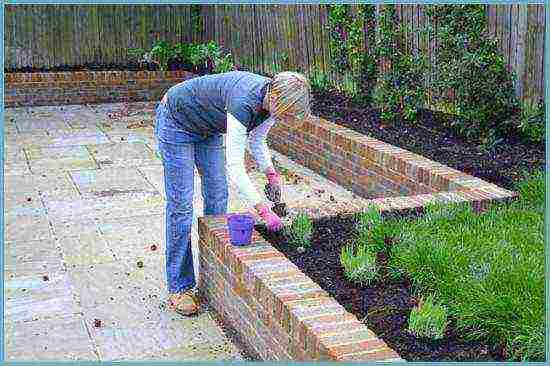
To make lavender bloom better - feed the plant with mineral fertilizers
Instead of Agricola, a solution of organic fertilizer Rossa Universal is also used, dissolving 2 tbsp. spoons in 10 liters of water.And the third option for feeding: 2 tbsp. l. dilute nitrophosphate and half a liter of liquid mullein in 10 liters of water. The consumption of the last two solutions is 10 liters per bush.
Plant propagation
Lavender is propagated by division, cuttings or layering.
Reproduction by division perhaps when there are already lavender bushes on the site. In summer, lavender produces a lot of young growth. It is something that can be rooted. To do this, you need to cut the plant and huddle in such a way that all the free space between the stems is densely filled with earth. And by the fall, the bush can be divided.

Dividing the lavender bush
The most suitable way to propagate home-grown lavender is propagation by cuttings... To do this, lignified annual shoots should be divided into cuttings no more than 10 cm and root.

Propagation of lavender by layering
The easiest breeding method, which is suitable even for novice gardeners, is reproduction by layering... With this method, in the spring, 2-3 shoots are carefully folded back and placed in a groove 3-5 cm deep, fixed, sprinkled with earth and watered. These shoots need to be watered a little more abundantly in order for the formation of lateral roots to occur successfully. After a year, the shoots are already completely independent, and you can plant them from the mother bush.
Diseases and pests
Lavender is not very susceptible to diseases, and parasites attack it infrequently, but this does not mean that nothing like this can happen. Of the diseases, gray rot is most common. Caring for a diseased plant consists in cutting off the damaged parts. The cut off parts must be burned.
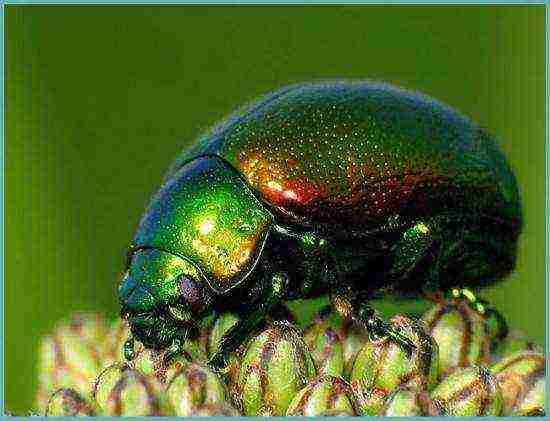
Monitor plant health and remove insects
From garden pests on lavender, you can find a rainbow beetle eating leaves. You need to collect it from plants by hand. But more often lavender is prone to the dominance of pennies, which do not cause any damage to the plant, but spoil the appearance pretty much, because they cover their larvae with a layer of white foam, which looks very much like saliva. Caring for lavender that has been attacked by pennies is very simple. It is enough to rinse off the foam with a stream of water.
Lavender: Combination with other plants
It is known that smells have a great influence on a person's subconsciousness. Therefore, when growing flowers, it is important that the flower bed is not only pleasing to the eye, but also enchants with its aroma. When planting plants, it is important to take care not only that the appearance of the flowers complements each other, but also that the floral aromas do not mix. This means that you will have to carefully consider the selection of flowers that you want to plant, otherwise you will hardly be able to rest or recharge in your garden.
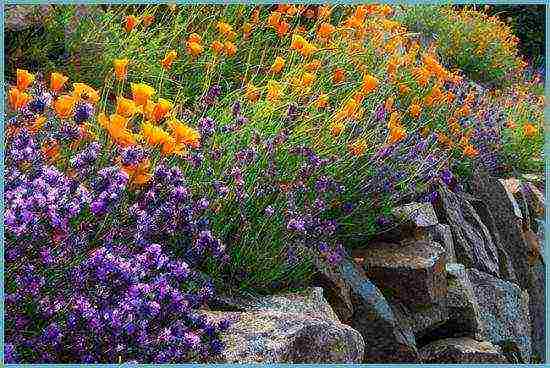
Lavender looks very good next to plants with contrasting colors.
Lavender goes very well with sage and catnip. She also looks amazing next to yarrow and garden hydrangea, liatrix, or surrounded by grown herbs and perennials.
Lavender in landscape design
Lavender, planting and caring for which is so easy that any budding gardener can handle it, is ideal for decorating an area. A significant advantage of lavender among other landscaping plants gives a bright and intense color in various shades, from pale pink to bright lilac. This makes it possible to accentuate the grace of any corner of your garden.

Lavender in landscape design
Advice. Use decorative designs to highlight the originality of your flower garden.
There are several options for decorating your garden with these flowering shrubs.
- Perhaps the most well-known and common way is to plant lavender along paths and sidewalks. This design of your site makes it possible to visually limit, as well as create a clear division of the garden into zones.
- The second option is to plant the bushes in such a way that the lavender will grow in accordance with the order of the cells on the chessboard.But this type of landing will only work on a completely horizontal surface.
- Another unusual way to emphasize the originality of a garden plot or flower garden is to form a "carpet" of these shrubs. If you decide to choose this option, you need to immediately determine the height of the lavender and regularly cut it at this level in the same plane. Such a carpet will not become a semblance of a soft grassy one on which you can comfortably sit, but planting shrubs in this way will allow lavender to brilliantly show its color.

Lavender is often planted along paths and fences.
Of course, lavender in landscape design is not as common as planting roses or all kinds of loaches, but this is what will emphasize the uniqueness and originality of the decorative design of your garden.
Growing lavender is the perfect way to highlight your garden or flower garden with color, shape, and an elegant scent that will impress everyone who walks by.
How to plant lavender correctly: video
Lavender in the garden: photo


